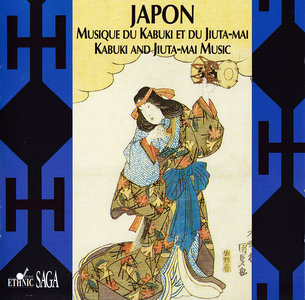VA - Japon: Musique du Kabuki et du Jiuta-Mai (1994)
EAC | FLAC | Tracks (Cue&Log) ~ 276 Mb | Mp3 (CBR320) ~ 141 Mb | Scans ~ 72 Mb
World, Japanese Traditions, Kabuki | Label: Auvidis | # B 6809 | Time: 01:01:35
EAC | FLAC | Tracks (Cue&Log) ~ 276 Mb | Mp3 (CBR320) ~ 141 Mb | Scans ~ 72 Mb
World, Japanese Traditions, Kabuki | Label: Auvidis | # B 6809 | Time: 01:01:35
Kabuki is one of Japan's typical theater genres, and it is still very popular today. It was created in the 17th century by a woman. As its popularity grew, it quickly became an entirely male art. Music plays a vital role in Kabuki. It sets the time and place of event; it expressed the actors' sentiments, for example. There are two types of plays in Kabuki: epic plays which recount the feats and deeds of the samurai class, and a more popular repertoire recounting the lives of the peasant and merchant classes. As for the Jiuta-Mai, it is the classical chamber music style of Japan. Before the 17th century, the voice was predominant, but afterward, in particular during the Edo period, the instrumental part became longer, taking a place thus far occupied by the voice. The Jiuta ensemble, also called Sankyoku (meaning "three instruments"), is composed of the shamisen, the koto, and the shakuhachi. This high-quality CD offers three excerpts from different Kabuki plays (of three different styles) and two works from the Jiuta-Mai repertoire. All these pieces are more than 200 hundred years old.



